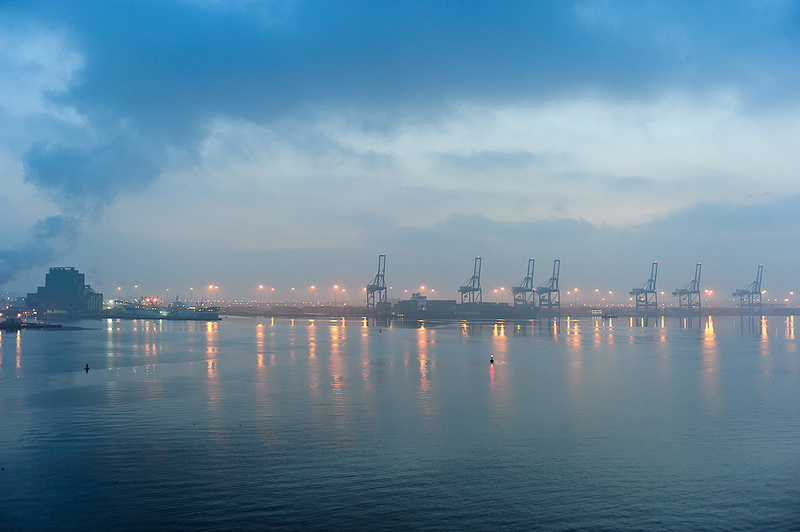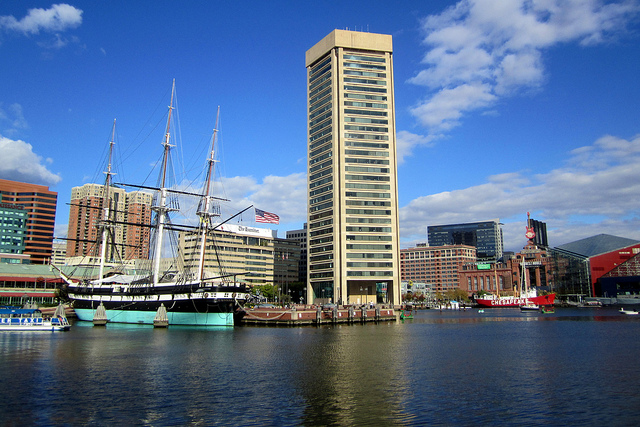Rising Sea 4: Storm losses pose enormous risk for Baltimore port
By Lucy Westcott And Caitlin Zentgraf
Capital News Service
Before Tropical Storm Isabel made landfall in September 2003, cranes were laboring under a clear blue sky, rushing to move cargo off flatbed trucks onto the Patagonia, the last container ship to head out of the Port of Baltimore before it closed for two days.
Outside, a skeleton crew worked, awaiting the arrival of Isabel’s powerful winds and drenching rain. Inside, Barbara McMahon, manager of safety, environment and risk management at the Maryland Port Administration, oversaw the tasks detailed in the port’s hurricane preparedness plan. Among them: tying down cranes, securing containers and mooring vessels.
Inner Harbor waters after Isabel rose more than 8 feet above normal levels and flooded terminal piers but did not reach any of the billions of dollars worth of cargo or equipment. The port had fared well.
More flooding ahead
The Port of Baltimore is a powerful economic engine. With more than 14,000 jobs, six public marine cargo terminals and one cruise terminal within the port, it broke records in 2012, handling, receiving and shipping 9.59 million tons of cargo worldwide.
But it’s all at risk.
The port is facing a future of more flooding. Sea levels are rising much faster on the heavily populated East Coast, about 1 foot in Maryland alone during the last century.
And the rise will continue rapidly – 1- to 2-feet over the next 50 years — according to Dr. Bilal Ayyub, director of the Center for Technology and Systems Management and professor of engineering at the University of Maryland, College Park, citing a study from the Maryland Department of Natural Resources.
Three years ago, the port administration prepared the report, “Climate Change Vulnerability Assessment and Recommendations,” which identified the need for infrastructure and facility improvements that deal with climate change and rising sea levels.
The loss of any port equipment would mean a huge financial hit. In February, the port completed construction of a new 50-foot-deep container berth at Seagirt Marine Terminal and installed four super-sized cranes from China — at a total cost of $40 million — equipped with anemometers that measure wind speed.
Impact of Hurricane Sandy has experts concerned
Experts are concerned, especially in the wake of Hurricane Sandy.
Ayyub studies the effects of climate change on infrastructure.
“The storms will become more extreme and the city of Baltimore has a lot of coastal infrastructure — the port amongst other things — and will end up experiencing higher water levels and higher waves … which will cause damage to the city,” he said.
Property will flood. And as more salt water mixes into the waters of the bay, infrastructure such as bridges will show signs of age, Ayyub said. Once the outside concrete layer of supports erode, the steel underneath will also be corroded by salt water, he said.
The Maryland Port Administration reviews its emergency preparedness plans often, particularly after every weather occurrence, which lets officials see its “lessons learned,” McMahon said.
The latest weather-related damage occurred June 10, when a waterspout spawned by a line of severe storms ripped off part of a port warehouse roof.
“Obviously, we have to be next to the water … Severe weather is not new to the port community,” McMahon said. “Most of our emergency preparedness plans have been developing for decades. It’s just a matter of revising. We are always testing new plans with drills and evaluating the pros and cons after.”
“There is no way to prepare for every imaginable type of weather occurrence,” she added. “Some are so unexpected, but others we know are coming. We can only predict what can happen by being next to the water — flooding, high winds, etc. — but we hope that we are prepared for the future when looking at projected climate change and rising sea levels.”
Storm surge flooded World Trade Center
McMahon said Isabel’s storm surge flooded the basement of the World Trade Center, which the MPA owns, in downtown Baltimore.
“We fixed that problem by raising the flood gates” at the World Trade Center, she said.
The port uses different plans for different weather emergencies, said Jim Dwyer, the MPA’s deputy director of planning.
In preparation for a hurricane, Baltimore looks to the Coast Guard, which has the final say on ship traffic into the channels of all U.S. ports. The port then must decide whether vessels need to hunker down or leave completely.
The U.S. Coast Guard in Miami gives the order to contact other ports in the region. A warning usually entails orders to tie everything down, steps that most ports take in weather emergencies. The protocols depend on the type of storm and where it will hit, said Mark Barney, spokesman for the U.S. Coast Guard in Miami.
When Hurricane Sandy shut down the New York and New Jersey ports last October, containers on the way to those stricken ports made calls at Philadelphia instead. The relocation lasted for about a month.
The Port of New Orleans, which lost power for a week during Hurricane Katrina in 2005, learned from the disaster.
“We’ve built smarter and have more stringent building codes out there now,” said Matt Gresham, director of external affairs at the Port of New Orleans.
And New Orleans still isn’t fully protected. Wetlands are buffers from storm surges and coastal erosion Ayyub said, so impact could be even higher without them — and New Orleans’ wetlands are shrinking at an alarming rate, Gresham said.
“We lose a football field of (wetlands) every day due to coastal erosion,” he said.
Increasing salinity hurts infrastructure like bridges
Rising sea levels also mean an increase in salinity, and salt water in places it typically isn’t, Ayyub said. Not only will it cause further damage to coastal areas and infrastructure, but also to the environment and vegetation.
But Richard Scher, director of communications at the MPA, said the Port of Baltimore isn’t expecting to suffer significant damage to infrastructure or change in operations due to an increase in salt water over the next 30 years.
“Rising sea levels are going to be a slow, plodding event, but climate change will give us bigger storms more frequently,” Dwyer said. “It’s not like we have to worry about it today.”
Dwyer said he’s more worried about the increasing size of vessels. As vessels get larger, so does equipment. Suddenly, maneuvering equipment, like the 400-foot-tall cranes from China, under the Bay and Francis Scott Key bridges has become a delicate task that has to take place during low tide to ensure clearance.
Baltimore’s bridges, including the Key Bridge, are all 183- to 185-feet above sea level, he said.
Cmdr. Angela Schedel, an engineering instructor at the U.S. Naval Academy and doctoral candidate in project management at the University of Maryland, College Park, researches the effects of climate change on coastal infrastructure, particularly the Norfolk Naval Base. Norfolk is experiencing the highest level of sea rise on the East Coast.
Sea level rise for Baltimore is 0.14 inches a year, whereas sea level rise for Norfolk is 0.18 inches a year, Schedel said. In Annapolis, the Naval Academy was severely flooded during Isabel in 2003, and watermarks 6 feet high are still visible.
As the weather becomes more extreme, Schedel urges either abandoning the soon-to-be dangerous locations of the Norfolk base and Port of Baltimore or adapting.
But, she said, while increased elevation of roads and structures could help, this takes money and time.
Government cuts to the military are not helping, and Schedel is concerned that money will continue to be spent on ships and other equipment rather than crucial infrastructure and repairs.
“We could use government money more wisely if we thought more future and forward-thinking.”

MarylandReporter.com is a daily news website produced by journalists committed to making state government as open, transparent, accountable and responsive as possible – in deed, not just in promise. We believe the people who pay for this government are entitled to have their money spent in an efficient and effective way, and that they are entitled to keep as much of their hard-earned dollars as they possibly can.



